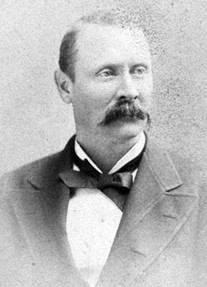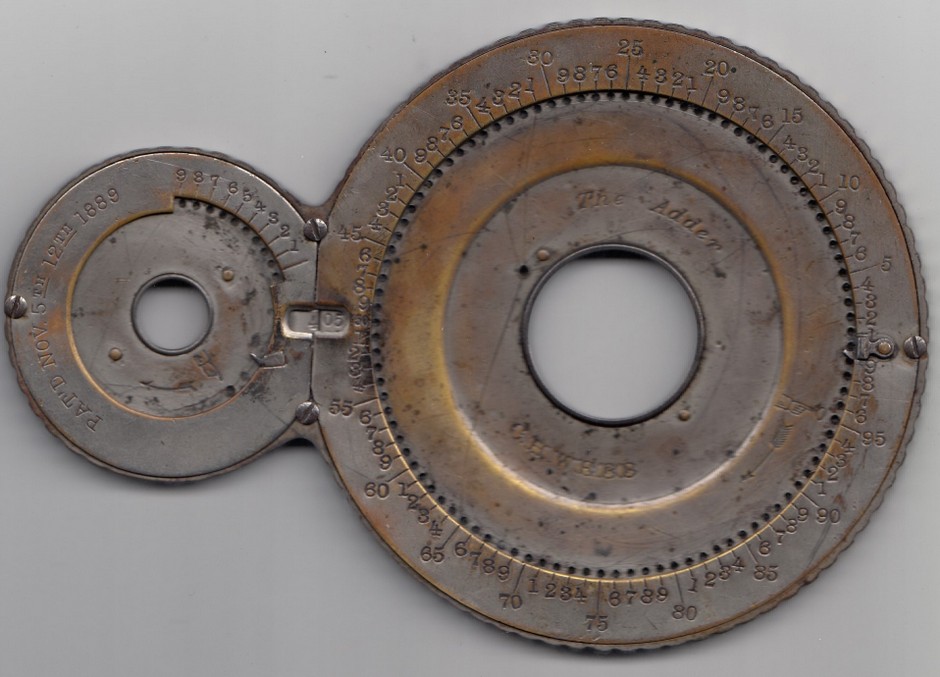Virtual Museum > The early ones > simple adding machines
the WEBB Adder

Around 1868, a journalist named Charles Henry WEBB invented a small device, made of 2 wheels, that could be used for adding numbers.

Not a great complexity, but the right side allows you to select one number from 0 to 100, and add it to whatever was previously entered. The left wheel counts how many time the right wheel made a complete turn, which means the number of 100s. You can also select a number on the left wheel if you want to add a number greater than 100.
The ADDER was patented on March 10, 1868, and you can see a copy of the patent below:
 Patent 75322 from 1868
Patent 75322 from 1868

Not a great complexity, but the right side allows you to select one number from 0 to 100, and add it to whatever was previously entered. The left wheel counts how many time the right wheel made a complete turn, which means the number of 100s. You can also select a number on the left wheel if you want to add a number greater than 100.
The ADDER was patented on March 10, 1868, and you can see a copy of the patent below:
 Patent 75322 from 1868
Patent 75322 from 1868 The first model was little different and set on wood.
Later, he improved on the design and deposited 2 additional patents, in 1889. One of them was under the name of his assignor (Mr SMITH). A copy of these 2 patents is also available below:
 Patent 414335 from 1889 under the name of SMITH
Patent 414335 from 1889 under the name of SMITH
 Patent 414335 from 1889 under the name of SMITH
Patent 414335 from 1889 under the name of SMITHhere is an extract from this patent showing the drawing, very similar to the actual model.
 Patent 414959 from 1889 under the name of WEBB
Patent 414959 from 1889 under the name of WEBB The machine was well constructed and able to add numbers using a wheel with 100 slots.Then the left wheel was automatically counting how many turn the right one did.
With numbers on the left going up to 50, the user could add numbers up to 50 x 100 = 5000 .
Later on, WEBB invented a different type of adding machine, looking very similar to the later golden GEM:
 Patent 465120 from 1891 showing the ribbon adder.
Patent 465120 from 1891 showing the ribbon adder.Curiously I found an ad showing the exact same device for sale under the company name: The Ribbon Adder. The price was $15, early 20th century, which not not negligeable. A typical job would give you 50 cents an hour.

And here is another one from 1893 in the Harper's magazine
One interesting thing is that several companies produced devices similar in shape and function to this adding machine. One good example is the HERRING calculating machine. By looking at the patent, the only difference is the addition of a small sliding mechanism on the right, to add constant values. As described in the patent, this was mainly designed for trains, to add the weight of cars. As most cars were of the same tonnage, it would be easier to add. But even the inside mechanism is similar to the one from Webb:
Above: Image from patent from John L Herring, delivered in April 1927 (almost 60 years after Webb)
Another interesting device is from a company in Austria, called NESTLER and ROESLER. They sold an adding machine that was absolutely identical to the Webb Adder, except of course the name on the front face. Not sure if this was known by Webb. I found a description of these machines in a French newspaper from 1903. No patent referenced anywhere.
Another interesting device is from a company in Austria, called NESTLER and ROESLER. They sold an adding machine that was absolutely identical to the Webb Adder, except of course the name on the front face. Not sure if this was known by Webb. I found a description of these machines in a French newspaper from 1903. No patent referenced anywhere.
Below is a short Video showing how to use the device, and how simple it was.
This page has been seen
times since August 2015
